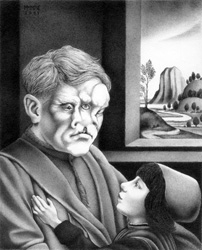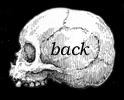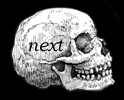|
|
Introduction

MY CABINET OF CURIOSITIES
The images in this series are not intended for the squeamish or faint of heart. They depict human remains and examples of extreme medical conditions,
many of which were fatal. This assortment of my photographs, drawings, and prints are my aesthetic reactions to these fascinating but uncomfortable objects.
What one will see here is not a random collection of bones and things in jars, but a record of an important segment of our shared
medical heritage. These anatomical preparations represent the intersection of science, culture, emotion and myth. Through these oddities,
one may catch glimpses of the evolution of modern medicine based on science rather than superstition.
In these images you are also viewing the bodily remains of those who suffered in life, but in death have helped to unravel the mysteries
of their diseases and injuries. As Gretchen Worden (1947-2004) once said about the objects displayed in her own Mütter Museum, “While
these bodies may be ugly, there is a terrifying beauty in the spirits of those forced to endure these afflictions, especially in the
past when so many were doomed to horrible and prolonged suffering before their death for lack of effective treatment and cure.Ӡ
While every specimen may be a record of personal tragedy, I would ask that you try to see not merely a misshapen limb or strange baby
in a jar but to consider how many were healed of disease and how many more babies are not in jars because of what was learned from that one. It is
through the study of what goes wrong that we have learned not only the mechanisms of disease but how healthy bodies function. Most recently, congenital deformities have
helped decipher the human genome, and these preparations continue to instruct.

ORIGINS OF THE SERIES
In 1998, I began to explore my long-time fascination with human oddities — those differently bodied people who once worked
in carnival and circus sideshows: freaks. I was first drawn in by the weirdness of their physical forms, but in time I
began to appreciate their biographies, the theatrical hyperbole of their public personae, and the hidden society in which
they operated and often flourished.
 From this study developed my series Prodigies: Congress of Oddities,
portraits of genuine sideshow performers placed within contexts borrowed from art history. Each portrait emerges after researching
the performer's history; then, that person is paired with a painting that reminds me of something from their act or biography —
or perhaps a gesture similar to the souvenir photos they sold during their shows.
From this study developed my series Prodigies: Congress of Oddities,
portraits of genuine sideshow performers placed within contexts borrowed from art history. Each portrait emerges after researching
the performer's history; then, that person is paired with a painting that reminds me of something from their act or biography —
or perhaps a gesture similar to the souvenir photos they sold during their shows.
As most of these individuals had unusual anatomies they naturally turn up in medical literature. In fact, showmen often sought out
the opinions of doctors in order to increase interest. Consequently, my research on sideshow often brings me into contact with medical museums.
Institutions of this sort owe their beginnings to the tradition of wunderkammern (literally, “cabinets of wonder”)
in which educated men of means from the Renaissance to the Enlightenment gathered and displayed unusual objects in an attempt to
understand and organize the natural world. In time, these collections would be left to universities, or find expression through the
so-called dime museums where showmen like P.T. Barnum displayed his human freaks alongside unusual objects.
It is this intersection of traditions that inspired Cabinet of Curiosities. This collection of my drawings,
photographs, woodcuts, and etchings documents these objects and seeks beauty within the grotesque. With the permission of museum curators,
I have been drawing and photographing these objects in situ and in the process creating a portrait of each collection. The style of
depiction I choose often depends on the context of its museum presentation: sharp clarity that speaks to clinical precision, or the murky
gloom of out-dated knowledge and dusty shelves.
Taken as a whole, this body of work is a tribute to those who endured unfortunate medical conditions but allowed their
experience to serve as means to understand the causes of their afflictions and help physicians to discover the means by which future
generations might be delivered from that misery.
James G. Mundie

† Worden, Gretchen. “Preface”, Mütter Museum of the College of Physicians of Philadelphia.
New York: Blast Books, 2002.
Image: Three-eyed Man and Child, ink drawing on paper, 2005, Collection of the late Stuart Katz, Laguna Beach CA (current whereabouts unknown)
|

|

|

|
All Images and Text © James G. Mundie
|

